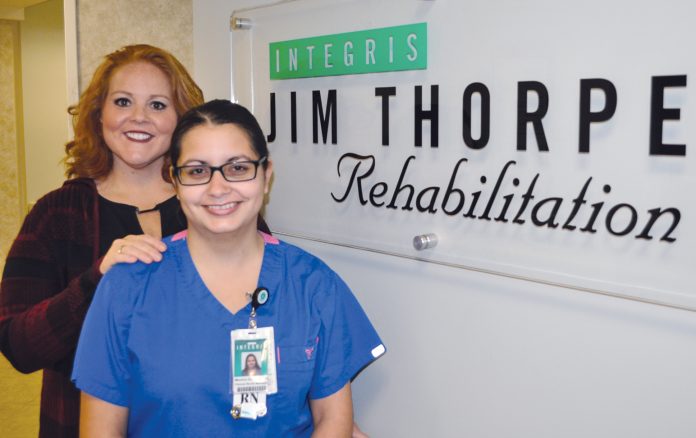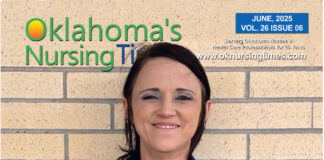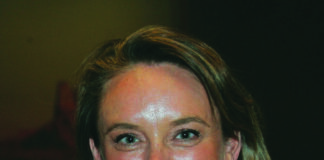
CAREERS IN NURSING
DRIVEN TO SUCCEED: INTEGRIS JIM THORPE REHABILITATION
by Bobby Anderson – Writer/Photographer
By 17, Monica Gregory had earned her certified nurse aide certificate.
Once the high school bell rang she would head down to the local nursing home for work.
Little changed when she moved to the metro.
She worked nights at Integris Jim Thorpe Rehabilitation’s second floor Friday through Sunday.
Monday through Thursday she went to school during the day at Oklahoma City Community College chasing her associate’s degree of nursing.
The money she earned at night helped pay for her studies during the day.
She understood it was all an investment in her future.
“I always knew I was going to be in healthcare some way or another,” said Gregory, who started working in Guymon.
After moving to the metro she started looking for jobs. Lucky for her, Jim Thorpe was one of the first to call her back.
It was during her tour of the facility she fell in love with rehab nursing.
Wheelchairs one day gave way to crutches the next. Crutches were cast off some time later and more often than not patients were walking out the front door on their way home.
“It’s more than just taking care of a patient for that day,” she said. “You get to watch the patient get better. We have patients that come back and visit us all the time. Even from when I was a baby nurse we still have those patients that come back to see us.”
“I like to see them get better and learn a new way of life if that’s what they need.”
Gregory jumped at every assistance program Integris offered eventually working in the nurse residency program.
Once she passed her boards she moved to days but still on the second floor for a few more years.
FLURRY OF ACTIVITY
From there she was tabbed to be a clinical nurse manager by an incoming nurse with big plans.
“I feel like it carries a sense of excellence, a sense of pride,” Clinical Director Natasha Flurry, RN, said of the Jim Thorpe moniker. “When you see somebody put everything they have every day just trying to get a little bit better it drives you to do better. That’s where that excellence comes, that grit.”
“Miracles happen here.”
Flurry heaps praise on Gregory for her work ethic and her ability to relate to others.
Maybe it’s because she traveled a similar road.
Flurry started on eight-hour night shifts as an aide as well.
“Back then I think they were called patient care associates,” Flurry said with a smile. “I’m an Integris baby. I did get some experience outside of Integris but I got to come back.
“Jim Thorpe was my heart.”
Hired on as the clinical director, Flurry found her role expand quickly. Nursing leadership was turning over and Flurry needed a partner.
“Monica was one of the top people that came through,” she said. “You meet her and see that she’s not willing to give up. Think about being 17 years old and working in a nursing home as a nurse assistance. Seventeen. What was I doing at 17? Not that.”
Gregory was also the first from her family to graduate college. A bachelor’s degree would come later.
“I want to work somewhere I’m proud to work and that’s here,” Gregory said.
Flurry sees that pride in Gregory and everyone else who works at Jim Thorpe.
And it makes her smile.
“This is truly the next generation of nursing leader,” said Flurry, a 16-year nursing veteran. “When I’m sitting around the table it feels good for me to talk about what is my next step as a nursing leader to know that someone will be ready to take on that role. It’s so important that we do that.”
PIE IN THE SKY
Flurry looks to the future with promise. “I think we’re on the path to empowering nurses to become and see things they haven’t seen before and the ability to think the way they’ve never thought before,” Flurry said. “With healthcare changing the way it does we have to have eyes to new ideas and ears to hear new things.”
Rehabilitation is changing from an acute care setting. It’s moving into the home. It’s involving home health, hospice and outpatient therapy.
“As a rehab nurse you have to see that whole shift,” Flurry said. “Being able to see things differently and how we operate over the next five years, I would love to see us transform rehab nursing into a more continuum of care.”
“It’s saying we are post-acute nurses.”












